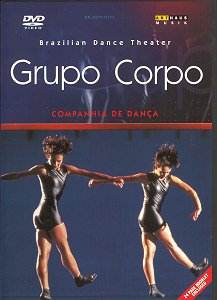This Grupo Corpo performance is a ritual of homage
to energy, youth and the beauty of the human body, the interplay of
the genders, the interaction of light, music and gesture. At times the
dancers are men and women. At times they are trying very hard to be
exactly the same; interestingly, they fail at this because guys and
girls do move differently no matter how hard they try not to. At odd
moments the dancers become a crowded sidewalk full of urbanites. A minute
later they’re apache dancers, then gymnasts, then they stand perfectly
still, then begin to move very slowly and may become strands of seaweed
billowing in the ocean current. They may also perform perfectly some
steps of classical ballet just to show that they really know how to
do that too.
The Bach arrangements are free but affectionate and
respectful. Curiously, only Bach’s tunes and textures are used. The
counterpoint is all in the dancers’ motions. At times we have songs
sung in German. At other times fragments of subjects merged are into
one another, at other times we hear whole allegro movements. The dancers
are not naked, of course; they’re wearing skin-fitting tennis outfits
at first black, then blue, then gold. They climb down out of a suspended
forest of long rods.
This is not a rock concert nor a night-club act. If
you are looking for raunchy, druggy hype; disco; chorus lines; jazz,
or ugly noise for its own sake you’ll be disappointed. If your only
idea of ballet is mid-key flat lighting, traditional costumes, dignified
gestures, gender-separate roles, full symphonic scores, and the ladies’
brassieres and gentlemen’s codpieces discretely padded with cotton so
as to avoid explicit anatomical details, you will not be happy. All
you’ll see is 43 minutes of callisthenics, acrobatics and naked strutting
about. Stay with your season ticket to the Ballet.
The documentary shows and tells how the group was formed
in 1975 in Belo Horizonte, Brazil, and how they put their productions
together, working as a family group. These are artists and dancers who
even in middle age do not forsake bright colours, theatrical stance
and dramatic gesture. Compared with maiden Aunt Agatha from Twickenham
they are very exotic looking people. Quite a number of their productions
are to classical works — a Mozart Mass, the Strauss Four Last Songs,
Elgar’s Enigma Variations — and I hope some of these are eventually
made available on DVD. Of course much of their work uses modern Brazilian
music but they are careful to avoid the banal or trashy.
The Bach piece is in ambient sound. O Corpo
is in stereo and the documentary soundtrack is monophonic, no matter
how many speakers you have.
Paul Shoemaker
